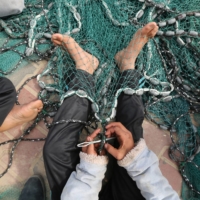Geneva – The world has marked the first rise in child labor in two decades and the coronavirus crisis threatens to push millions more youngsters toward the same fate, the United Nations said Thursday.
In a joint report, the International Labour Organization and the U.N. children’s agency, UNICEF, said the number in child labor stood at 160 million at the start of 2020 — an increase of 8.4 million in four years.
The hike began before the pandemic hit and marks a dramatic reversal of a downward trend that had seen child labor numbers shrink by 94 million between 2000 and 2016, it said.
Just as the COVID-19 crisis was beginning to pick up steam, nearly 1 in 10 children globally were stuck in child labor, with sub-Saharan Africa the worst affected.
While the percentage of children in child labor remained the same as in 2016, population growth meant that the numbers rose significantly.
And the pandemic risks worsening the situation significantly, the agencies said.
They warned that unless urgent action is taken to help ballooning numbers of families plunging into poverty, nearly 50 million more kids could be forced into child labor over the next two years.
“We are losing ground in the fight to end child labor,” UNICEF chief Henrietta Fore told reporters, stressing that “the COVID-19 crisis is making a bad situation even worse.”
“Now, well into a second year of global lockdowns, school closures, economic disruptions and shrinking national budgets, families are forced to make heart-breaking choices.”
If the latest projections of poverty increases due to the pandemic materialize, another 9 million children will be pushed into child labor by the end of 2022, the report said.
But statistic modelling shows that number could potentially be more than five times higher, according to UNICEF statistics specialist Claudia Cappa, who co-authored the report.
“If social protection coverage slips from the current levels … as a result of austerity measures and other factors, the number of children falling into child labor can go up (an additional) 46 million” by the end of next year, she said.
The report, which is published every four years, showed that children between the ages of 5 and 11 accounted for over half of the global figure.
Boys were significantly more likely to be affected, accounting for 97 of the 160 million children toiling in child labor at the start of 2020.
But the gender gap narrows by half when household chores performed for at least 21 hours per week are counted, the report said.
Particularly concerning, perhaps, was the significant increase seen in children between the ages of 5 and 17 who are doing so-called hazardous work, which is deemed to affect a child’s development, education or health.
This can include toiling in dangerous industries, like mining or with heavy machinery, and working for more than 43 hours a week, which makes schooling next to impossible.
A full 79 million children were considered to be doing such hazardous work at the start of 2020, up 6.5 million from four years earlier, the report showed.
The study revealed that most child labor is concentrated in the agriculture sector, which accounts for 70% of the global total, or 112 million children.
Some 20% of child labor, meanwhile, happens in the service sector and around 10% in industry, it found.
The greatest increase in child labor was seen in sub-Saharan Africa, where population growth, recurrent crises, extreme poverty and inadequate social protection measures pushed an additional 16.6 million children into child labor since 2016, the report found.
Nearly a quarter of children between the ages of 5 and 17 in sub-Saharan Africa are already in child labor, compared with 2.3% in Europe and North America.
The U.N. agencies warned that additional economic shocks and school closures caused by the pandemic meant that children already in child labor may be working longer hours and under worsening conditions.
And many more risk being forced into the worst forms of child labor due to job and income losses among vulnerable families, the report said.
“The new estimates are a wake-up call,” ILO chief Guy Ryder said in a statement.
“We cannot stand by while a new generation of children is put at risk,” he said, stressing that “we are at a pivotal moment and much depends on how we respond.”
“This is a time for renewed commitment and energy to turn the corner and break the cycle of poverty and child labor.”
In a time of both misinformation and too much information, quality journalism is more crucial than ever.
By subscribing, you can help us get the story right.
SUBSCRIBE NOW



